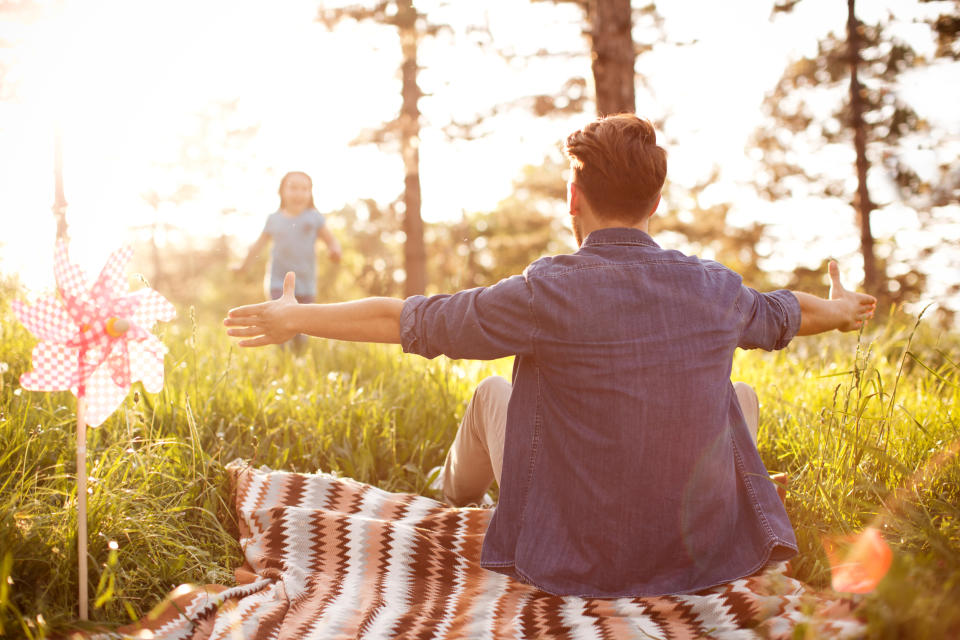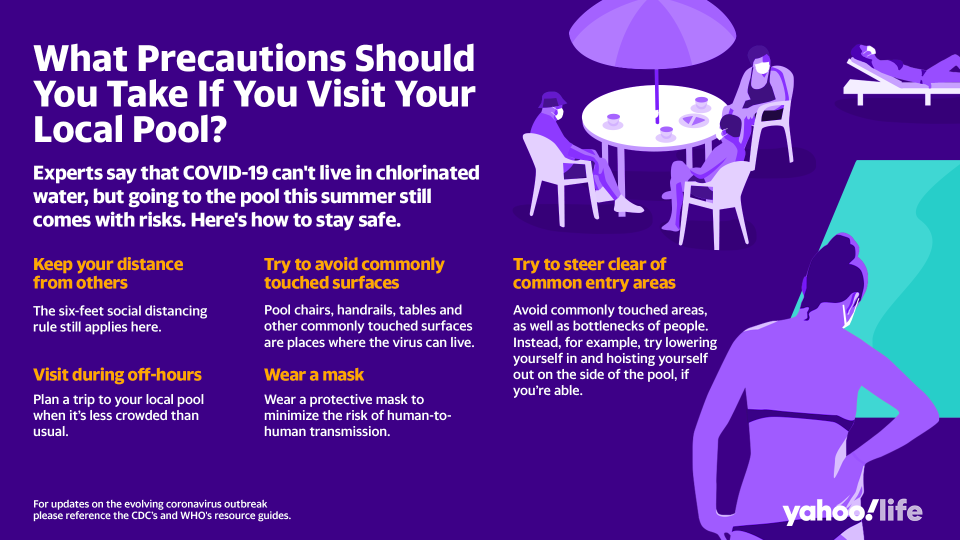A guide to being outside safely this summer during the coronavirus pandemic
It’s become incredibly clear that, thanks to the COVID-19 pandemic, this summer is going to be unique. Even though people are getting out more, public health officials still recommend that you do your best to limit your contact with others, keep at least six feet away from people outside your household as much as possible, wash your hands regularly and wear a mask when you’re in public.
But while you’re probably well aware of the general recommendations, there are plenty of situations you might find yourself in this summer where you’re unsure of what, exactly, you need to do to keep yourself and your family safe.
Many things come down to your personal risk tolerance, Dr. Amesh A. Adalja, a senior scholar at the Johns Hopkins Center for Health Security, tells Yahoo Life. “Going outside and interacting with other people comes with some level of risk of contracting coronavirus,” he says. But given that you probably want to live your life with some degree of normalcy, Adalja says it’s up to you to decide how comfortable you feel in certain situations where there may be other people.
Another important thing to keep in mind is that homemade masks only offer some level of protection. “In most situations, wearing a mask is to protect other people, not you,” Dr. David Cutler, a family medicine physician at Providence Saint John’s Health Center in Santa Monica, Calif., tells Yahoo Life. “If other people would wear a mask, that would protect you. That’s why everyone should wear a mask.” Still, Adalja says that “there’s a lot of controversy about what masks do, especially ones made by the general public.” So, he says, don’t assume you’re protected if you’re wearing a mask – social distancing as much as possible is the best course of action.
Planning to get out a little – or a lot – this summer? Keep these precautions in mind when you find yourself in different situations.

Going to the beach
Many beaches have recommendations about wearing masks and staying six feet apart, but it’s often up to individuals to actually do this, Dr. William Schaffner, an infectious disease specialist and professor at the Vanderbilt University School of Medicine, tells Yahoo Life. In general, you’ll want to limit how many people you’re there with – ideally, you’d just be at the beach with your household, Schaffner says. You also want to keep at least six feet from others as much as possible, he says. “Watch the kids. Kids want to play with each other, but you need to keep them apart,” Schaffner says.
If you’re spread out from other people, Schaffner says you’re probably OK to not wear a mask. But it’s a good idea to wear a mask when you venture into more crowded areas, like the shoreline, he says.
Hiking on a trail
“If there’s no one around you, there’s no one that can infect you,” Adalja says. Different hiking trails may have their own rules but, in general, Adalja says it’s important to try to keep your distance from others who aren’t in your household.
One area to be wary of, though, is the parking lot. “That’s the tricky part,” Schaffner says. “There can be a lot of congestion at the parking lot and trailhead.” If the area is crowded, you may want to try to hike at another time. Or, if you still want to hike, you can try parking further away from the trail where this is more room to space out.
Playing golf or other outdoor sports
Person-to-person contact is the big issue here, Schaffner says. He cites the locker room, bar and pro shop as some of the biggest potential exposure risks. “Be safe, keep your distance from others as much as possible, wash your hands and put a mask on,” Schaffner says.
Keep in mind that it can be tricky to maintain social distancing with outdoor sports like beach volleyball, soccer, and baseball, he says.

Visiting a public pool
Some public pools are closed, but others are open with restrictions. Schaffner is most concerned about close contact with other people. “Stay apart and put chairs further apart,” he says. Ideally, your local pool will limit attendance to make this easier, Schaffner says. But, he adds, “Things can easily get jammed up.”
Schaffner also recommends steering clear of high-touch areas like handrails (if you can) and the water fountain as much as possible and using hand sanitizer after you touch common areas. “The risk of transmission on surfaces is very low, but it’s not zero,” Dr. Henry F. Raymond, associate director for public health at the Rutgers School of Public Health, tells Yahoo Life.
Browsing your local farmer’s market
Adalja compares this to going to the grocery store. “It’s basically the same thing,” he says. Most farmers’ markets have put measures in place to try to reduce crowds and will likely require you to wear a mask, Cutler says. “Stay six feet away from others to protect you,” he says. Keep in mind that you’ll likely be handling things that other people have touched, too, like your credit card or produce, so Adalja says you should do your best to avoid touching your face and wash your hands when you can.
Running on a track
Every track will have its own rules and it’s important to follow them. If you can wear a mask while you run, great. “But that can be difficult if you’re running hard,” Schaffner says. Running tracks can get crowded, which is why Schaffner recommends trying to go during off-peak hours. “It’s less convenient, but should have lower attendance,” he says.
Visiting a local park
The rules are the same here as they are for using a local trail, Adalja says. “Avoid crowded areas and keep your distance from others,” he says. If someone else happens to get a little too close to you for a moment, don’t panic – just move away. “We don’t think that fleeting contact with someone will pass the infection between you,” Adalja says. “It’s significant exposure—10 to 30 minutes of exposure within six feet of each other.”
Staying at a campground
Spacing your campsite out from other people is important, Raymond says. “You want to stay as isolated from other people as much as possible,” he says. If you’re planning to camp with friends, he recommends having them get a campsite near you and doing social distancing meet-ups.
The communal bathroom has the biggest potential for the spread of the virus, Raymond says. If you can, try to avoid going in when other people are there and wash your hands well afterward. Also, “I wouldn’t want to go in right away after other people,” Raymond says.
Staying at a hotel or B&B
Many hotels and B&Bs have precautions in place to try to keep you safe, like regularly disinfecting commonly-touched surfaces and rooms, Adalja says. However, he adds, you can wipe down things like door handles and faucets before using them if you want to be extra cautious.
Your biggest concern is areas where people congregate, like at the checkout desk, hotel pool and in dining areas, Schaffner says. If you can, he says it’s a good idea to avoid those areas and to get room service or takeout to try to avoid crowds.
Using a public restroom
In general, experts say you want to do what you can to avoid using a public restroom. But things happen, and you might find yourself in a situation where you or a family member needs to go. “The biggest concern is being within six feet of someone where they can cough and sneeze on you, and share their germs that you can breathe in,” Cutler says. If it’s possible, Raymond recommends waiting outside the bathroom until it’s empty before you go in. If not, wear a mask, try to space yourself out from other people while you’re in there, wash your hands well when you’re done and try not to use the door handle on the way out. Also, don’t linger. “You want to get in and out,” Raymond says.
Overall, experts stress that all of these activities come with some level of risk and that it’s important to figure out how comfortable you feel about it. “There are some people going to the gym in New Jersey who don’t care,” Raymond says. “Others are still changing their clothes and showering as soon as they get home. You have to figure out how comfortable you are with risk.”
For the latest coronavirus news and updates, follow along at https://news.yahoo.com/coronavirus. According to experts, people over 60 and those who are immunocompromised continue to be the most at risk. If you have questions, please reference the CDC’s and WHO’s resource guides.
How to maintain your physical and mental health during the pandemic
Taking care of a loved one with COVID-19? Here’s how to stay healthy
Q&A with Dr. Kavita Patel: How to keep your family safe and maintain your mental health
Read more from Yahoo Life
Want daily lifestyle and wellness news delivered to your inbox? Sign up here for Yahoo Life’s newsletter.



